Corsair Obsidian 250D Case Review
by E. Fylladitakis on January 21, 2014 12:00 PM EST- Posted in
- Cases/Cooling/PSUs
- Corsair
- Mini ITX
- Case
Corsair Obsidian 250D Interior
The all-black interior of the Obsidian 250D is very roomy for a Mini-ITX case. As we mentioned on the previous page, the interior of the Obsidian 250D is split so that the motherboard is installed horizontally on the top half of the case. A metallic frame forms the motherboard's tray but is no longer than the motherboard itself, allowing for the easy routing of cables in-between the compartments of the case.
It is noteworthy that the frame is almost entirely open beneath the motherboard, in order to allow for the installation of high-end coolers while the motherboard is still installed inside the case; however, the opening leads directly to the PSU partition, meaning that the PSU will have to be removed before attempting the installation/removal of a CPU cooler. Nevertheless, though perhaps not even Corsair realized this, the opening can also work to the advantage of overclockers. If the PSU is placed with its fan facing upwards, it will be drawing air from beneath the motherboard, effectively cooling the motherboard in the process.
To the right side of the case, which is where the top side of the motherboard will be, the frame of the Obsidian 250D with the help of a removable middle support brace is designed to support the installation of 2 × 120 mm fans. One fan, a very quiet A1225L12S-2 sleeve bearing 1300 RPM fan, has been installed from the factory. Liquid coolers with up to 2 × 120 mm radiators can also be installed here. Note however that liquid coolers with "enhanced capacity" (thick) radiators will not fit in the Obsidian 250D; only radiators up to 28 mm thick will fit.
An intake 140 mm fan has been installed on the front of the case, again a sleeve bearing model from the same manufacturer (Hong Sheng) and with a maximum speed of just 1000 RPM. The design allows this fan to be replaced by a 200 mm fan if required, which is probably overkill for a Mini-ITX system. A 140 mm liquid cooler radiator may also be installed here as well, regardless of thickness this time.
The metallic brace that holds the 5.25" device may be removed from the case entirely and we strongly suggest its removal before the installation of a full system, as it allows for much easier access to the interior of the case. A plastic lock on the side of the metallic frame holds the optical drive in place, no tools are needed; however, the installation of other accessories that are meant to be mounted in a 5.25" bay, such as fan controllers, may not be possible at all, as there are no front row holes for the installation of such devices. The two holes at the bottom of the brace look like they could be used for the installation of a 3.5" device but they do not align with the holes of a hard drive. The brace has no functionality at all if no 5.25" device is installed, which is a shame as it could easily be designed so as to support smaller devices instead, thus it is probably best if left removed entirely unless the user wants an optical drive.
As expected, a Mini-ITX motherboard is a perfect fit inside the Obsidian 250D, although the spacious tray can easily fit a little longer and/or wider motherboards as well, should any special "high-performance" ITX designs arise in the near future -- a scenario that is not unlikely considering the fever surrounding the ITX format lately. A CPU cooler of about up to 14.5 cm tall may fit, which is not enough for monster tower air coolers, denoting that the Obsidian 250D is mostly optimized for the presence of a liquid cooling solution. Nevertheless, the clearance is more than enough for plenty of very good air coolers. It can be seen that the Obsidian 250D actually has two expansion slots instead of one, regardless that currently no Mini-ITX motherboard has more than one expansion slot. This however was necessary for the installation of high-performance GFX cards, which require two consecutive expansion slots.
The 2.5" / 3.5" drive trays must be accessed from the rear of the case, after the removal of four thumbscrews. Two 2.5" and two 3.5" trays can be found in the Obsidian 250D, all supporting the tool-less installation of SSDs/HDDs; the trays simply lock the drives with metallic studs, no screws required. The 3.5" trays can also hold 2.5" devices if needed.
Due to its design, an installed PSU can span nearly the full depth of the case. Pretty much any ATX power supply will fit in the Obsidian 250D, irrespective of its length. The installation of a power supply with an output greater than 500-600W for a Mini-ITX system though is most likely going to be pointless, regardless of the system installed, as no single CPU and the most powerful GFX card that may fit inside the Obsidian 250D can use that much power. Due to its relatively compact size and design, we strongly suggest buying a power supply with few short cables and preferably a modular model as well. Visually and technically, Corsair's new CS series would most likely be a great fit.
Large, powerful GFX cards are no problem for the Obsidian 250D -- though not too large, as only cards up to about 295 mm long will fit. Once installed, the card's intake fans align perfectly with the side panel opening, allowing the card to draw fresh air in from the side of the case. The installation of our test GTX 770 card proved a little troubling though, as there is not enough clearance for the support brace of the card to enter the opening of the expansion slot easily. As a result, the card will touch both the motherboard and the frame of the chassis during installation, as shown in the picture below for your reference. Pushing it into place requires force, and we are not really fond of pushing metallic braces against the edge of our motherboards. We do not think this is a major problem or that it will create significant difficulties for any user, but we do think that a clearance of a few more mm is required for larger GPUs.
With the motherboard at the middle of the case and the PSU/Drives at its bottom, most of the cables will amass at the front bottom part of the case, where there is plenty of space. Thankfully, the Obsidian 250D also is literally filled with cable tie mounting points, allowing for modders to work wonders when it comes to cable management. The design of the Obsidian 250D allows for all of the cables to be instantly routed out of the way of the motherboard and major components (i.e. the parts which will be visible via the windowed top panel).


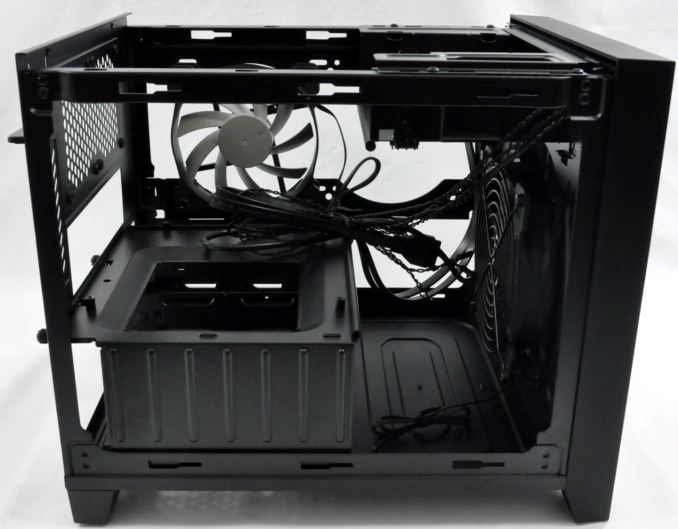





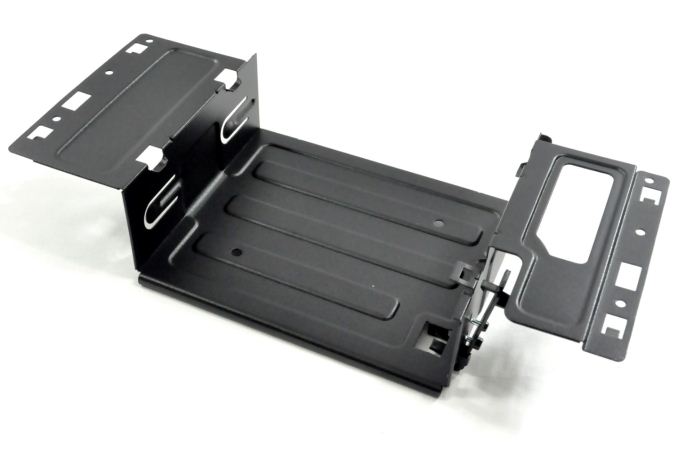

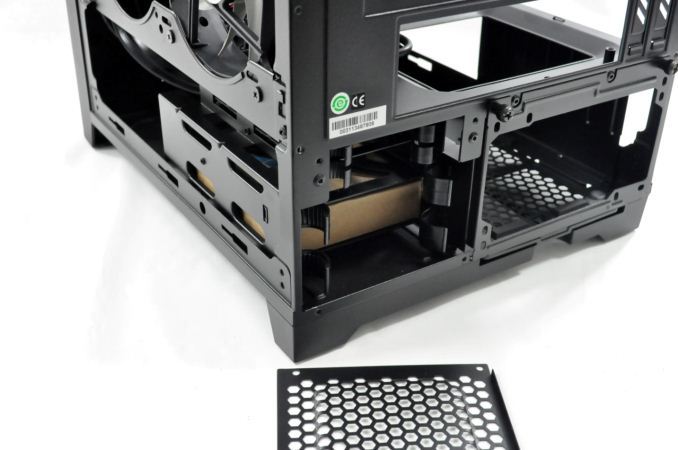
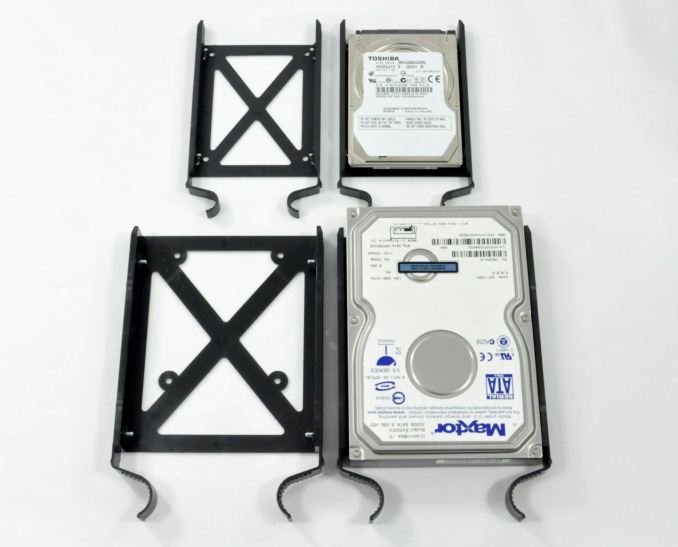
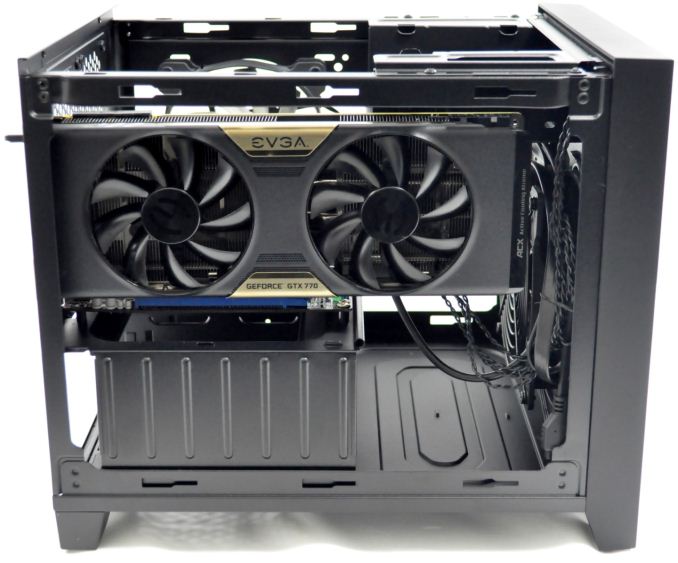
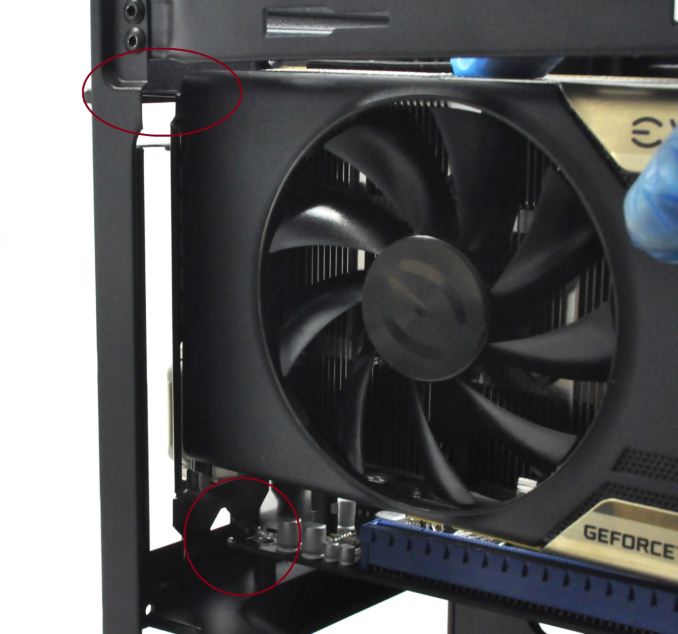
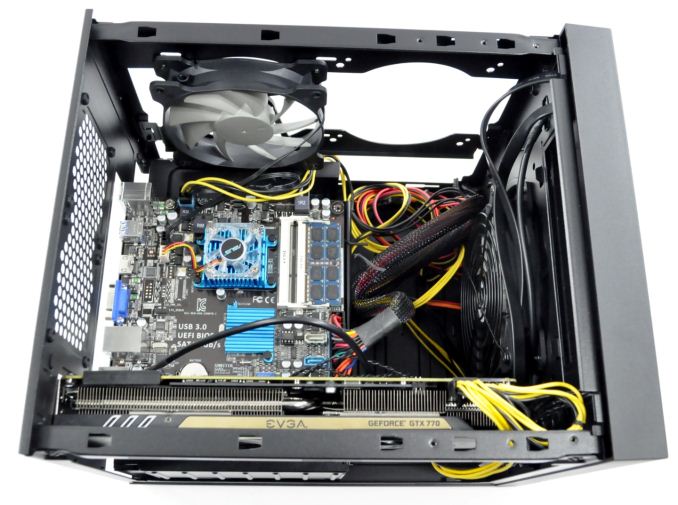








52 Comments
View All Comments
E.Fyll - Tuesday, January 21, 2014 - link
There is no comparison with a real system simply because that would be entirely misleading. Testing a case with a real system is an improper procedure and can lead to greatly misleading results. Real systems are active loads and interact with their environment, which makes every single system unique. Each such system would favor some designs over others, therefore comparisons between systems would have been useless. Even if you build the same exact system, using parts from the exact same OEMs, even a different orientation of a single cooler could yield entirely different results.The synthetic load which we are using emulates the heat dissipation of a system (multiplied a few times) but does not aid the cooling capabilities of the case in any way. Therefore, we can assess the true stock thermal performance of the case, regardless of the system that will be used or any modification that the user will perform.
sleepytea - Tuesday, January 21, 2014 - link
I was really looking forward to this review, but it turned out to be a big disappointment for two reasons. First, the review format completely breaks the mold and makes no direct comparison to previous mini-itx builds. I want to see this case compared against it competitors, especially the ones that have been reviewed here in the past. The only other case mentioned is a HTPC case by silverstone which is completely irrelevant. The Sugo sg08 has an excellent review and would be a much more relevant comparison point.Second, the writing is flat and uninteresting. Dustin Sklavos has been the man for the job up to this point and I'm not sure if he is no longer on staff here, but he had a history with these mini-itx builds and the combination of his writing talent, personal interest in the form factor, and experience testing SFF builds made for excellent and trust worthy reviews.
Egg - Tuesday, January 21, 2014 - link
Corsair hired him, you can look up his twitter at @DTheSleeplesslmcd - Tuesday, January 21, 2014 - link
I was confused about Dustin's no-show, and the "About Anandtech" hasn't been updated with the info.And while the writing was flat, there's no question that we now have a new writer and Anandtech community member who I'm sure will become more personable as we batter him to bits down here ;)
thesavvymage - Tuesday, January 21, 2014 - link
according to another commenter here, corsair hired him. his twitter handle is @dthesleeplessDustin Sklavos - Wednesday, January 22, 2014 - link
Aw, it's nice to be missed. I'm still doing system reviews here and there for AT, but yeah, Corsair occupies my time now. I'm writing for their blog now and doing a lot of in-house testing, I'm also part of the development process for products you'll be seeing towards the end of this year and into next year. :)E. came highly recommended and I think once he gets situated, his voice will become more apparent. My early stuff at AT was much more formal and academic the way his is here. Frankly I think his testing methodology here is more scientific and reliable than mine was. It's good work all around that I'd only expect to improve, and he's definitely AnandTech material.
sleepytea - Wednesday, January 22, 2014 - link
That's all great to hear and I do look forward to seeing what comes from Corsair and mr. Fylladitakis in the future. Cheers!CloudFire - Tuesday, January 21, 2014 - link
I would think it'll be so awesome if you guys did video reviews of computer products on youtube similar to how Hardware Canucks does, seeing a video presentation of the review would be something I'd love to see from anandtech.spidey81 - Tuesday, January 21, 2014 - link
"Corsair created the Obsidian 250D for enthusiasts who want to create a fully featured, powerful gaming system in compact dimensions.""...installing USB 3.0 only front panel ports without providing an adapter for USB 2.0 motherboard headers is a bad call, as very few Mini-ITX motherboards have a USB 3.0 header."
I'm not sure what you're trying to say here, but after doing a quick search on the Egg for Z77/Z87 M-ITX motherboards (most likely the choice of chipset for gamers/enthusiasts aka the target audience) ALL of the 8 motherboards that came up had USB 3.0 front panel headers. Even the comparable AMD boards were equipped with them. It's only when you start entering budget and lower mainstream boards that you see USB 3.0 front header being left off. And per your quote, that's not the target audience for this case.
E.Fyll - Tuesday, January 21, 2014 - link
Indeed, per my quote, Corsair's target audience is that of gamers and enthusiasts. However, many mainstream and lower budget boards do not have an USB 3.0 header. As you said, a high performance board which has an USB 3.0 would "likely be the choice" of the target audience. That however is a hypothesis; someone could easily want to install an Asus asus c8hm70-i/hdmi and use it as a HTPC. It could become an issue for some users, therefore I had to mention it.